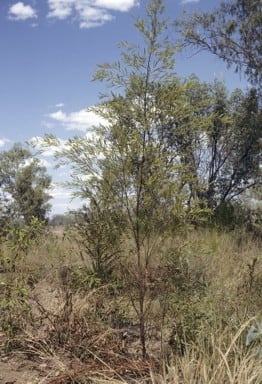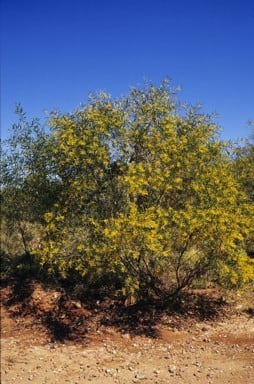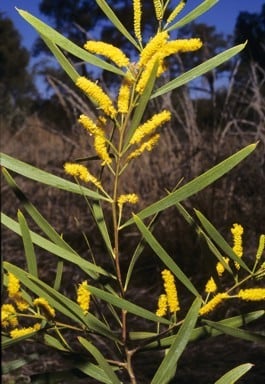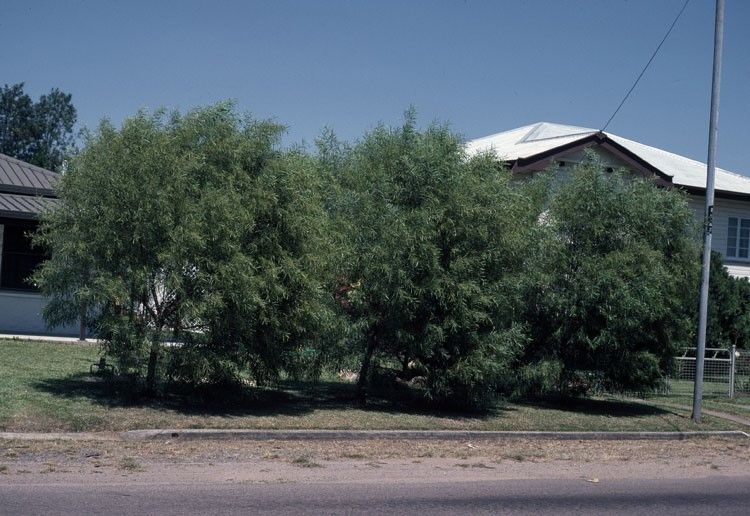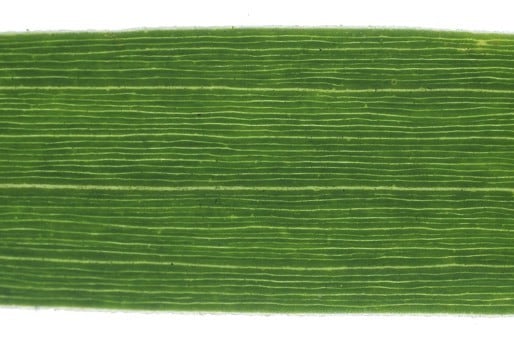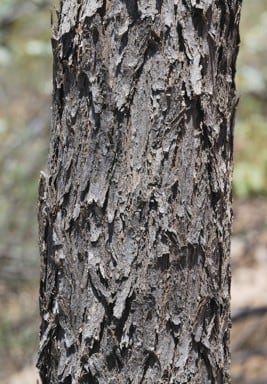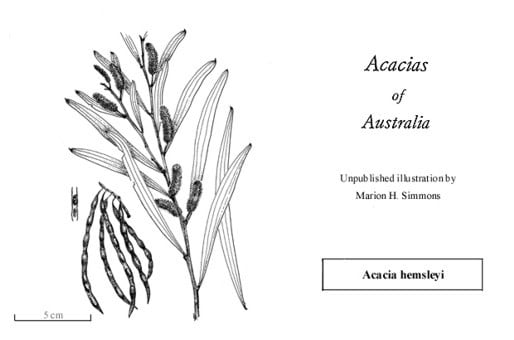Acacia hemsleyi Maiden
WATTLE
Acacias of Australia
Family
Fabaceae
Distribution
Occurs in tropical Australia (W.A., N.T. and Qld) N of 21ºS; very common in north-western Qld.
Description
Slightly resinous shrub or tree to 7 m high. Bark slightly fissured or shreddy. Upper branchlets commonly angular, otherwise terete, glabrous; upper ridges often resin-convoluted. Stipules triangular, brown, 1–2 mm long, often persistent. Phyllodes linear to very narrowly elliptic and linear-oblanceolate, straight or slightly curved, (4–) 5–12 (–14.5) cm long, (3–) 5–12 (–14) mm wide, acute to obtuse with a ±setose point normally 1.5–3 mm long at apex, thinly to moderately coriaceous, glabrous; longitudinal nerves numerous, with mostly 2 or 3 slightly prominent main nerves continuous from base to apex and 2 or 3 secondary nerves; minor nerves 5–10 per mm, often slightly anastomosing; gland 1, to 3 mm above pulvinus. Inflorescences simple; peduncles 5–12 mm long, glabrous; spikes 1.5–3 cm long. Flowers 5‑merous; calyx 0.4–1 mm long, dissected for 2/3, ciliate and puberulous to ±glabrous; corolla 0.9–1.6 mm long, dissected for 1/2 or more, ±glabrous; ovary densely pubescent. Pods linear, with straight edge or slightly constricted between seeds, 5–10 cm long, 2.5–5 mm wide, firmly chartaceous to thinly coriaceous, glabrous. Seeds longitudinal, ±elliptic to oblong-elliptic, 4.5–5.5 mm long, dark brown; pleurogram with halo; areole closed or almost so, paler than rest of seed.
Phenology
Flowers June–Sept.
Habitat
Grows in gravelly sands on river beds and creek banks and on sandy beaches in mangrove communities.
Specimens
W.A.: Barker R., W.V.Fitzgerald 1535 (NSW). N.T.: Border water hole, Highland Plains Stn, N.M.Henry 224 (DNA, NSW); Cove S of East Neck on Centre Is., Gulf of Carpentaria, B.Rice 2042 (K, NSW). Qld: Herbert R., Rockingham Bay, 1 Aug. 1863, J.Dallachy (NSW); 10 km N of Mount Isa on the Barkly Hwy, P.Ollerenshaw 1178 & D.Kratzing (BRI, CANB, NSW).
Notes
This species is allied to A. plectocarpa and A. hammondii, both of which have transversely arranged seeds in the wider and/or undulate pods. Seemingly rare hybrids between A. hemsleyi and A. gloeotricha occur in the Kimberley region, W.A. A toxic substance, probably saponin, has been reported in the pods of A. hemsleyi.
FOA Reference
Data derived from Flora of Australia Volumes 11A (2001), 11B (2001) and 12 (1998), products of ABRS, ©Commonwealth of Australia
Author
Dr M.D.Tindale and Dr P.G.Kodela with the assistance of M.Bedward, S.J.Davies, C.Herscovitch, D.A.Keith and/or D.A.Morrison
Edited by B.R.Maslin
This identification key and fact sheets are available as a mobile application:
URL: https://apps.lucidcentral.org/wattle/
© Copyright 2018. All rights reserved.

